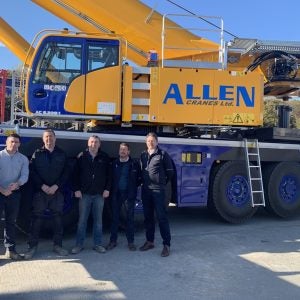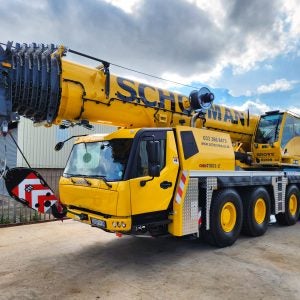Since launching its own reachstaker in 2004, Liebherr is now well established in the market with more than 30 machines in operation in Europe, the Americas, Asia and Africa.
Liebherr said there are a number of advantages, which convinced it to go for such a unique drive concept when developing its reachstacker.
As a basic principle, it said, the hydrostatic transmission is characterised by a high power density, which means small dimensions of components as well as small induced masses. This gives the reachstacker fast acceleration and added efficiency.
In contradiction to conventional reachstackers, stepless acceleration and deceleration is implemented to the Liebherr machine as there are not any regulation steps. Liebherr said this does not only have a positive impact on the lifetime of various components but also adds to the driving comfort for the operator.
Another feature of a hydrostatic transmission is its high output at already low revolutions, deriving from the earlier mentioned small induced masses. Furthermore, it is characterised by good controllability.
With conventional reachstackers the powerpack can only be installed in the centre of the machine due to a centrally located differential gear. The hydrostatic transmission does not request any particular place of installation for the powerpack but gives a free choice to the design engineer.
Having made use of such opportunity, the entire powerpack has been placed to the right-hand side of the Liebherr reachstacker where service and maintenance staff experience incomparable access to all essential service points.
The braking power can effectively be used for the “working hydraulics” and the basic load and such working hydraulics are not located behind the torque converter, which, again, increases the efficiency factor.
The hydrostatic transmission is not only characterised by smaller but also less components. Obviously, Liebherr said, this has a positive impact on the service and maintenance costs as well as on the overall reliability of the machine.
With conventional reachstackers a rigid, non-steerable drive axle is used due to the high axle loads which occur. The drive axle is fitted with differential gears and planetary gears arranged centrally in the wheel hubs. These differential gears are driven either mechanically or hydrostatically.
Service braking takes place via dry or wet-running multi-plate brakes, while the holding brake consists of a spring-loaded disk brake. The non-driven, steerable axle is used as the steering axle.
A floating bearing is predominantly used to compensate for uneven driving surfaces. The wheels at the steering axles are fitted with, and partly without, a service brake or holding brake. The steering is carried out via one or more hydraulically actuated steering cylinders.
With such conventional design, there is the disadvantage of a high tyre wear in the steering axle which in particular arises on pronounced steering movements as a consequence of the central drive and the inner friction in the differential gear.
A differential lock is moreover required for the transfer of the drive power to the ground if one side of the driving axle is located on a slippery, smooth surface.
Only conventional steering is possible due to the previously described axle support. Transverse driving, say, driving 90 degrees with respect to the vehicle frame, and slanted driving, the so-called “dog gait” are not possible. Only a limited manoeuvrability is hereby given. Moreover, due to the rigid axle arrangement, no height compensation is possible when driving on a sloped plane.
With the implementation of the individual wheel drive, Liebherr’s revolutionary innovation on the reachstacker market, individual wheel hubs with integrated planetary gears and hydrostatic drives are provided for the driven wheels.
Every driving wheel or every pair of wheels can be controlled individually due to this solution. It is thereby possible to supply as well as to actively influence different drive powers to the respective drive wheels. Consequently, it is manageable to build up a steering torque which supports the steering movement and the stability of the reachstacker.
The lateral forces at the steering wheels can hereby be reduced almost completely, which has a substantial impact on the lifetime of the steering wheels.
Another advantage is the reduced strain on the steering wheels and thus the increased running performance of the wheels. Furthermore, traction is also increased on a slippery, smooth surface due to this individual wheel drive as the wheels can be individually supplied with a maximum possible driving torque depending on the traction present. Even an anti-slip control for each individual wheel is possible.
On top of that the individual wheel drive adds to increased turnover figures at less cost. Since facing no time delay when steering more stability and less wobbling are to be noticed by the driver thus assisting him in achieving better turnover rates. And due to a more effective driving gear, less fuel consumption and less gear oil are being recorded by the service and maintenance staff.






